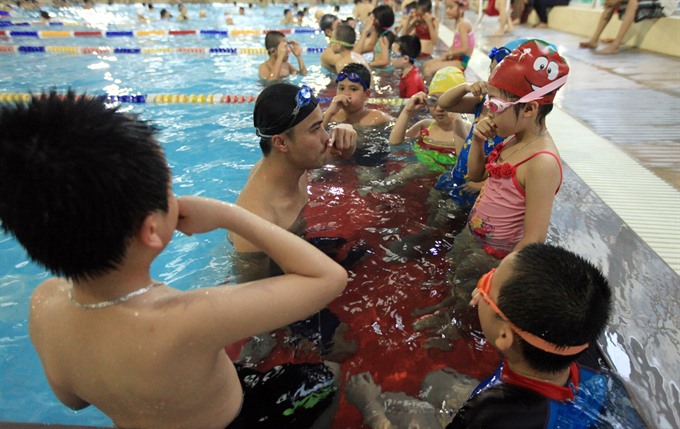Two third of VN children can’t swim
Drowning is still one of the leading causes of mortality among children in Việt Nam, despite efforts to deal with the problem. Concern is re-surfacing ahead of the coming summer months.

Children learn swimming at Tăng Bạt Hổ swimming pool in Hà Nội’s Hai Bà Trưng District. Drowning is still one of the leading causes of mortality among children in Việt Nam.-VNA/VNS Photo Anh Tuấn
Đặng Hoa Nam, director of the Child Care and Protection Department, said many children go swimming when it’s hot but do not have swimming skills.
Though Việt Nam boasts 3,260km of coastline and many rivers and lakes, swimming is only taught as an extra-curricular activity or at courses outside schools.
A recent survey by the department found only 35 per cent of children in the Mekong Delta and 10 per cent in the Red River Delta can swim.
The rate of children who can swim in cities is lower than in rural areas, according to the department.
In late 2010, the Government approved a 10-year strategy aimed at having all schools include swimming lessons in their extra-curriculum activities and universalise swimming among all students by 2020.
Drop in deaths
All provinces were instructed to pilot swimming programmes in primary schools by 2015, with a focus on third, fourth and fifth grade students.
The situation appears to have been somewhat improved. Ministry of Labour, War Invalids and Social Affairs data shows that the number of children who died of drowning dropped from 3,300 in 2012 to 1,800 in 2014.
Nonetheless, the goals are still far from fulfilled as most schools can’t teach swimming regularly due to a lack of swimming instructors as well as money and land to build pools.
Vũ Duy Anh, an official from the Ministry Education and Training, said teaching students to swim had been difficult due to limited funds and poor infrastructure. “Many schools don’t have swimming pools and it is difficult to build them depending only on State fund,” he told Nông Thôn Ngày Nay (Countryside Today) newspaper.
The ministry has encouraged schools to work with organisations and inpiduals to hold swimming courses in and outside schools.
Dương Thị Sáu, head of education and training office in Hà Nội’s Đông Anh District, said only 30 per cent of students in local schools could swim, although the capital has many lakes and ponds.
Deputy Minister of Labour, War Invalids and Social Affairs (MoLISA) Đào Hồng Lan advised schools to be more creative, suggesting using pools made of waterproof materials instead of cement, or swimming training in rivers instead of waiting for funds from the State.
Poor families
Last week, at least 10 drowning cases occurred, with more than 10 children dying in Bình Phước, Tiền Giang and Quảng Ngãi provinces. Two of the dead were aged eight, Việt Nam Television reported. These children came from poor families and their parents were at work when the incidents occurred, it reported.
On April 25, two secondary school children in the central province of Quảng Ngãi drowned at a waterfall in Sơn Hà District. Earlier, four other sixth grade students in Gia Lai Province were reported to have drowned in a local river.
Nguyễn Trọng An, former deputy director of Child Care and Protection Department of MoLISA, attributed the problem mainly to the carelessness of families and concerned agencies.
“Leaders of provinces and cities will find solutions to overcome current difficulties, such as funds to build pools or organise swimming courses for local children if they are really interested in the children’s rights and safety,” An told Việt Nam Television recently.
They could seek investment from organisations, inpiduals and the community, he added.
The ministry sent a letter requesting the People’s Committees of provinces and cities to strengthen work to prevent children drowning, Nam said.
Provinces would also need to review areas where drowning is common to ensure the safety of children during summer, rainy and flood seasons.
Localities were urged to set up warning signs at dangerous ponds and holes, increase communication activities to raise public awareness and mobilise efforts from different ministries, sectors, and communities to prevent child drowning, An said./.
VNF/VNS
Recommended
 National
National
Vietnam News Today (Nov. 27): Ample Opportunities For Vietnam – Bulgaria Economic, Trade Cooperation
 National
National
Vietnam News Today (Nov. 27): Vietnam Seeks Danish Assistance in Green Energy Development
 National
National
Vietnam, Malaysia Look Forward to New Era of Development
 National
National
Vietnam News Today (Nov. 26): Party Leader Receives Bulgarian President
 National
National
Vietnam News Today (Nov. 25): Cambodia Attaches Importance to Defense Cooperation With Vietnam
 National
National
General Secretary To Lam Meets Vietnamese Community During Embassy Visit in Malaysia
 National
National
Vietnam News Today (Nov. 24): India, Vietnam Strengthen Coordination Capability in UN Peacekeeping Operations
 National
National
